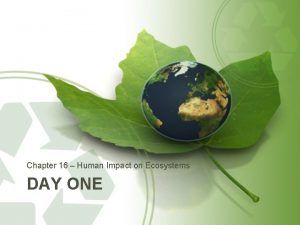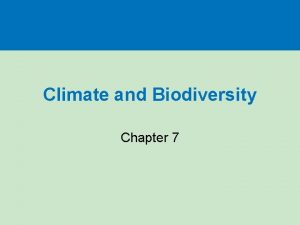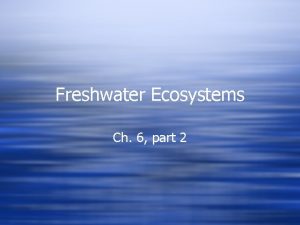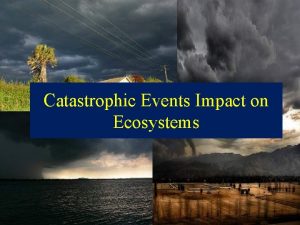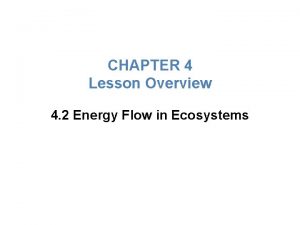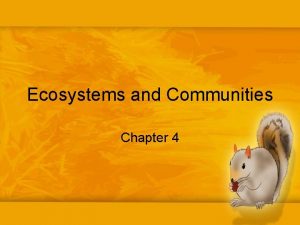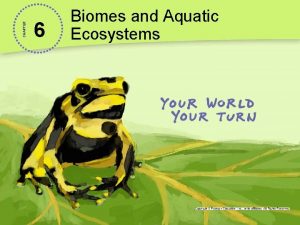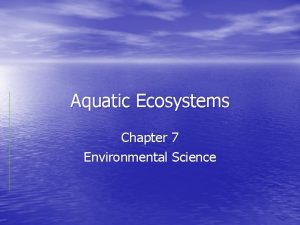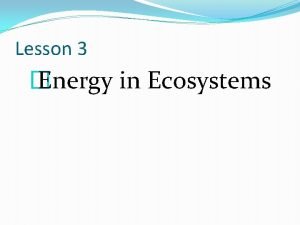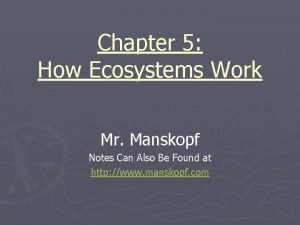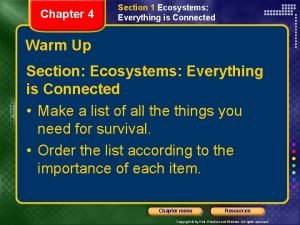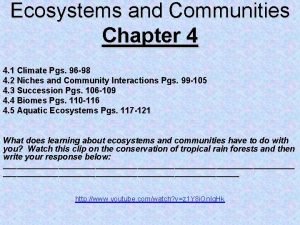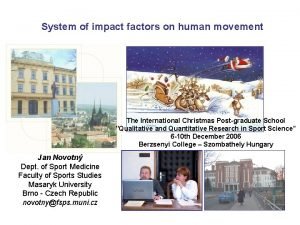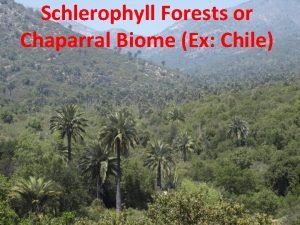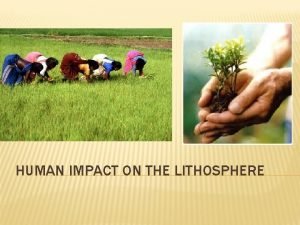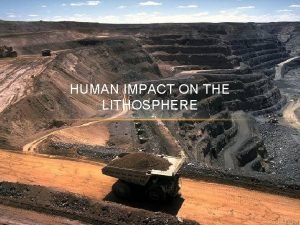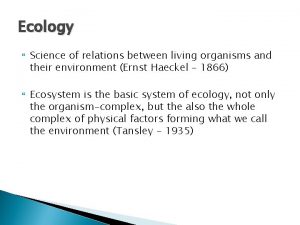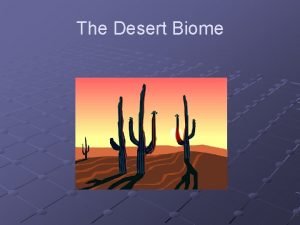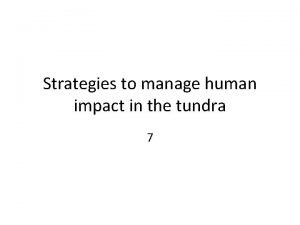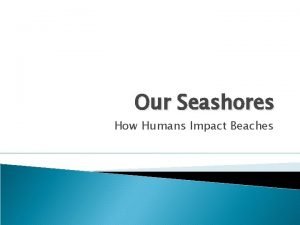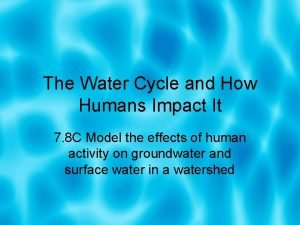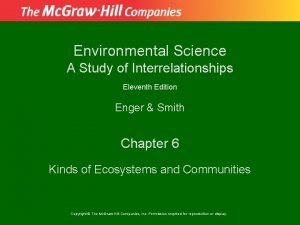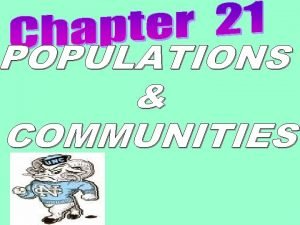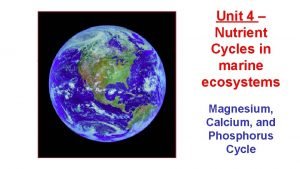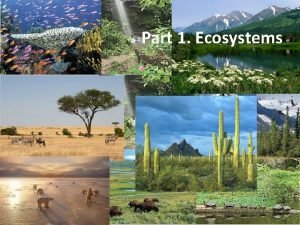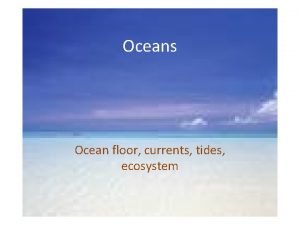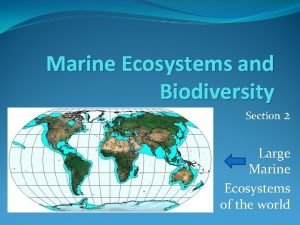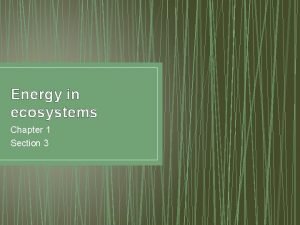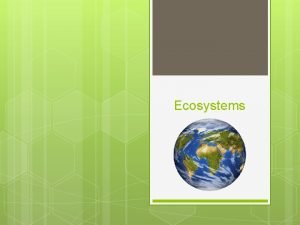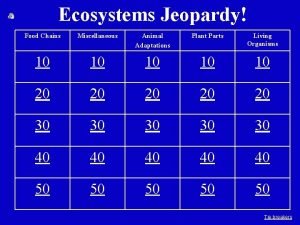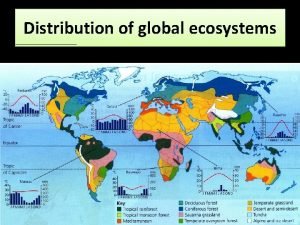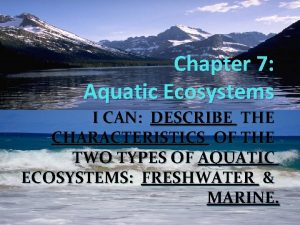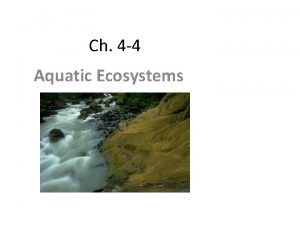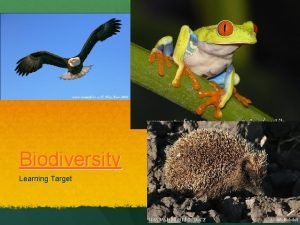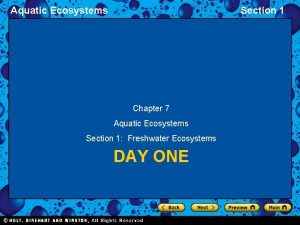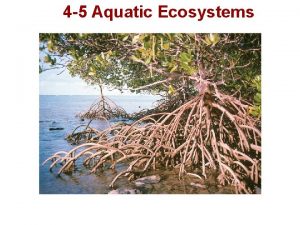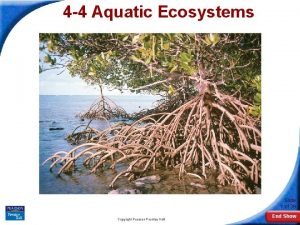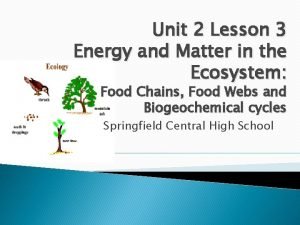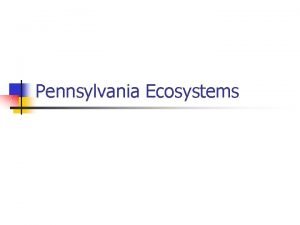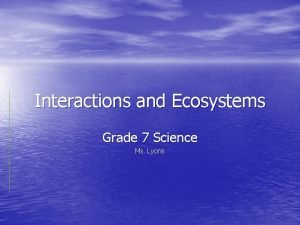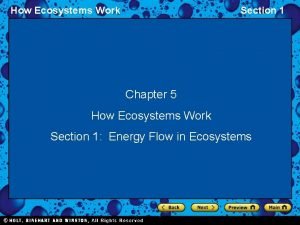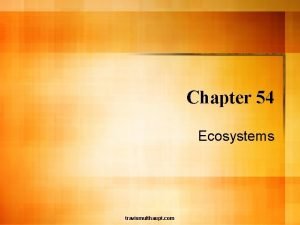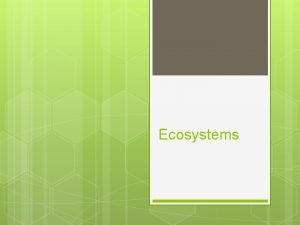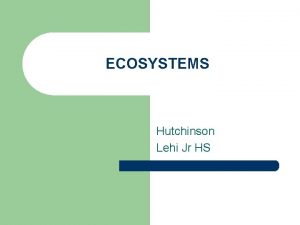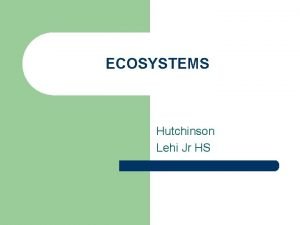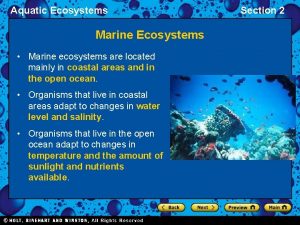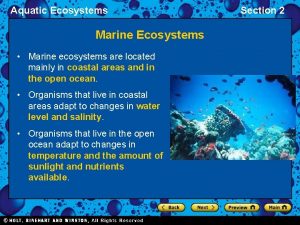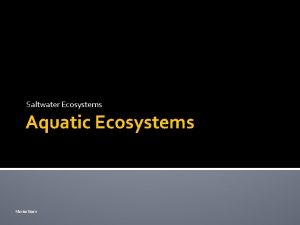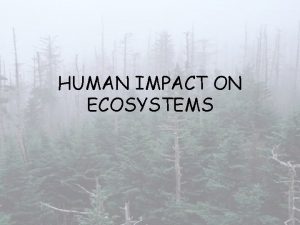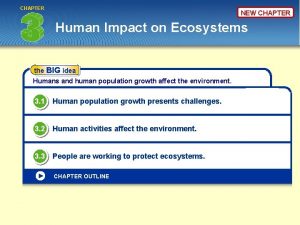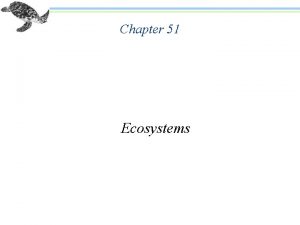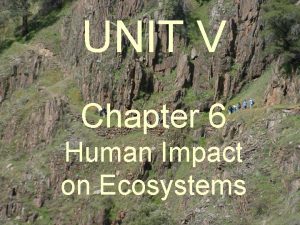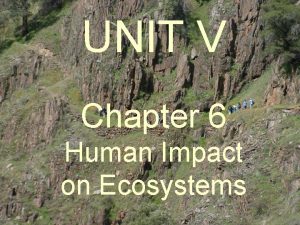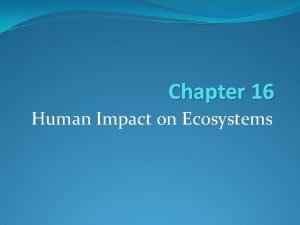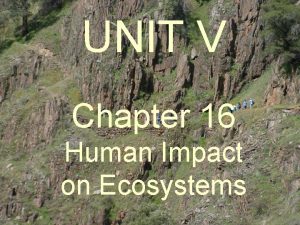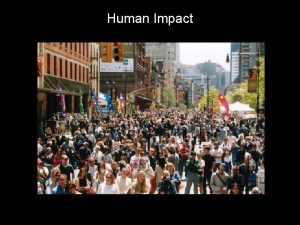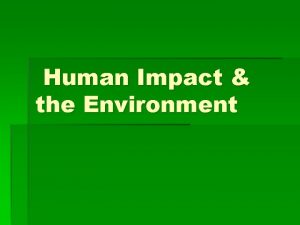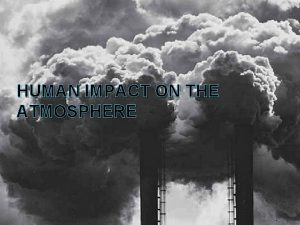Chapter 6 Human impact 6 1 Ecosystems provide






























































- Slides: 62

Chapter 6 Human impact 6. 1 Ecosystems provide us w/ “services” Recycling nutrients clear air & water O 2 food soil & more


Human activities affecting biosphere: Hunting & gathering- few demands Agriculture- ~11, 000 ya Industry- factories & machines (~200 ya) Urban development- waste & pollution


Traditional→modern agriculture: Monoculture-large fields planted with same crop every year Green revolution-fertilizers & monoculture to increase world food supply


6. 2 Environmental services are either renewable or nonrenewable Renewable resources-can be replenished Ex: some trees or H 2 O

Nonrenewable resources- can’t be replenished by natural processes Ex: fossil fuels, old forests

Sustainable development-using natural resources w/o depleting them Ex: using insects instead of pesticides to control pests


LAND RESOURCES Land can be permanently damaged if not managed properly Crops grow best in a mixed soil (sand, clay, rock pieces, & humus) Good soil is made by plant/soil interactions over a long time

Long plant roots hold soil in place & prevent erosion from wind & water Plowing removes these roots

Farmers can use contour plowing to reduce erosion Desertification- farming, overgrazing & drought turn productive lands into deserts


http: //www. youtube. com/watch? v=w 9 Rxnu. Bi. Fbg

FOREST RESOURCES Forests– O 2, clean water, nutrients, clothes, shelter, & medicine Deforestation-causes erosion Erosion- wearing away of soil by H 2 O or wind How can we use sustainable development in forests?


FISH RESOURCES Overfishing- big problem How can we sustain our fish? Aquaculture-raising aquatic animals for food

Air resources Smog-mix of chemicals (brown haze) in the sky; {cars & industry} Pollutant-harmful material that enters biosphere via land, air, or water

Acid rain- nitrogen and sulfur compounds in the air; burning fossil fuels form acids when mixed with H 2 O vapor Damages plants, releases other bad chemicals into biosphere


Freshwater resources Drinking, cleaning, crops, & other Forests & wetlands purify water we must protect them

Water damaged by: Chemicals Sewage Industry waste


6. 3 Biodiversity-total variety of all organisms in biosphere

Ecosystem diversity-includes the variety of habitats, communities, & ecological processes in biosphere


Species diversity-number of different species in biosphere (~1. 5 million spp. so far) Genetic diversity-total of all diff. forms of genetic info on earth

Why is biodiversity so important? Threats to biodiversity Extinction- species disappears from all or part of its range Endangered species- in danger of extinction

http: //www. youtube. com/watch? v=ZTTEdew. T 1 x. U


Habitat fragmentation-development that splits ecosystems into pieces Remaining pieces are “biological islands”


Page 152 in book Introduced/invasive speciesnonnative plants & animals can take over HOW? ?

Video on Burmese pythons http: //archives. nbclearn. com/portal/site/k-12/search

http: //video. nationalgeographic. com/ video/animals/amphibiansanimals/frogs-and-toads/toad_cane/

Biological magnificationconcentrations of a harmful substance ↑’s as trophic levels ↑ Ex: mercury, DDT

Mercury in fish http: //archives. nbclearn. com/portal/site/k 12/search


Conservation-wise management of natural resources What little things can you do to conserve biodiversity?

6. 4 Ozone layer-b/w 20 -50 km above earth is a high concentration of ozone gas O 3

On ground ozone is a pollutant ozone layer absorbs UV CFC’s (chlorofluorocarbons) caused big hole CFC’s were banned in late 1980’s


http: //video. nationalgeographic. com/video/ne ws/environment-news/antarctica-ozone-vin/

Global warming- ↑ in average temperature of biosphere What can we do?

http: //video. nationalgeographic. com/video/environment/globalwarming-environment/glacier-melt/


Video: Education | A Global Warming Warning | Watch Nature Online | PBS Video

Solutions: Alternative fuels– made from biomass Biodiesel- is made from vegetable oils & animal fats. Biodiesel can be used as a fuel for vehicles in its pure form Ethanol- (also propanol & butanol)-- most commonly worldwide; made by the action of microoraganisms & enzymes through the fermentation of sugars or starches or cellulose from corn, wheat, sugarbeets, etc. . Algal-This oil-rich algae can be processed into biofuels, with the dried remainder further reprocessed to create ethanol Fungal- isolate lg amts of lipids from single-celled fungi and turn it into biofuels in an economically efficient manner

Alternative/renewable energy 1. Wind power- renewable & sustainable Pro’s: clean, cheap once it is set up, abundant, used anywhere Cons’: kills birds/bats, need open space & constant wind, noise, ↑ ground tm

http: //video. pbs. org/video/2173872043/

2. Solar-renewable & sustainable; no greenhouse gas emission Pro’s: clean, abundant, quiet, efficient, low operating cost Con’s: expensive to start, not always sunny, need lots of space

http: //video. nationalgeographic. com/video/environment/energyenvironment/solar-cooking/

3. Hydroelectric- renewable & sustainable Pro’s: low pollution, safe, reliable, flexible, low upkeep Con’s: damage to ecosystem, expensive, droughts, limited

http: //video. nationalgeographic. com/video/ne ws/environment-news/yangtze-ride-wcvin/

4. Geothermal- renewable & sustainable Pro’s: no CO 2, no fuel needed, limitless, reliable Con’s: uses H 2 O, high initial cost, difficult, far from where it’s needed

http: //archives. nbclearn. com/portal/site/k-12/search Geothermal power: using earth’s heat to heat homes

5. Hydrogen- renewable & sustainable Pro’s: no CO 2, abundant, efficient, quick Con’s: not enough stations, availability, hard to separate H

http: //archives. nbclearn. com/portal/site/k 12/search Is hydrogen the fuel of the future?

6. Nuclear (fusion)- renewable Pro’s: clean, limit, low cost, less, little waste Con’s: expensive to build, need high temperature, hard to contain, waste disposal

http: //archives. nbclearn. com/portal/site/k 12/search Nuclear energy reconsidered: zero greenhouse gas, but deadly waste

 Chapter 16 human impact on ecosystems
Chapter 16 human impact on ecosystems Chapter 16 human impact on ecosystems
Chapter 16 human impact on ecosystems Human impact on terrestrial ecosystems
Human impact on terrestrial ecosystems Human impact on freshwater ecosystems
Human impact on freshwater ecosystems How can flooding impact ecosystems
How can flooding impact ecosystems Chapter 27 human impact on earth resources
Chapter 27 human impact on earth resources Chapter 3 section 3 aquatic ecosystems
Chapter 3 section 3 aquatic ecosystems Chapter 4 lesson 2 energy flow in ecosystems answer key
Chapter 4 lesson 2 energy flow in ecosystems answer key Chapter 4 ecosystems and communities vocabulary review
Chapter 4 ecosystems and communities vocabulary review The chaparral biome is best characterized by _______.
The chaparral biome is best characterized by _______. Why biomes are important
Why biomes are important Phosphorus cycle pearson education
Phosphorus cycle pearson education Chapter 42 ecosystems and energy
Chapter 42 ecosystems and energy Chapter 3 lesson 3 biomes and aquatic ecosystems
Chapter 3 lesson 3 biomes and aquatic ecosystems Limestone ridges built by tiny animals
Limestone ridges built by tiny animals Chapter 4 lesson 2 energy flow in ecosystems answer key
Chapter 4 lesson 2 energy flow in ecosystems answer key Chapter 7 aquatic ecosystems test answers
Chapter 7 aquatic ecosystems test answers Chapter 5 how ecosystems work study guide
Chapter 5 how ecosystems work study guide Chapter 55 ecosystems and restoration ecology
Chapter 55 ecosystems and restoration ecology Section ecosystems everything is connected
Section ecosystems everything is connected Unit 5 ecology
Unit 5 ecology Chapter 4 ecosystems and communities
Chapter 4 ecosystems and communities Human movement science impact factor
Human movement science impact factor Chile biome
Chile biome Human impact on lithosphere
Human impact on lithosphere Human impact on agriculture
Human impact on agriculture Human impact on the phosphorus cycle
Human impact on the phosphorus cycle How are deserts formed
How are deserts formed Human impact on the tundra
Human impact on the tundra Human impact on beaches
Human impact on beaches Human impact on groundwater
Human impact on groundwater Human impact on oceans
Human impact on oceans What is an energy role
What is an energy role Chapter 8 human needs and human development
Chapter 8 human needs and human development Chapter 8 human needs and human development
Chapter 8 human needs and human development Pollution effects on ecosystems
Pollution effects on ecosystems Biological use of magnesium in marine ecosystems
Biological use of magnesium in marine ecosystems Lesson outline lesson 2 aquatic ecosystems answer key
Lesson outline lesson 2 aquatic ecosystems answer key Ecosystem living and nonliving things
Ecosystem living and nonliving things What are the objectives of ecosystem
What are the objectives of ecosystem Ocean food chain
Ocean food chain Ecosystems examples
Ecosystems examples Interactions in the environment grade 7
Interactions in the environment grade 7 Section 3 energy in ecosystems
Section 3 energy in ecosystems Ecosystems title page
Ecosystems title page Examples of biotic factors
Examples of biotic factors Adaptations of a dandelion
Adaptations of a dandelion Distribution of global ecosystems
Distribution of global ecosystems Marine ecosystem webquest
Marine ecosystem webquest Secondary succession definition biology
Secondary succession definition biology Section 4-4 aquatic ecosystems
Section 4-4 aquatic ecosystems Why biodiversity is important
Why biodiversity is important Differences between aquatic and terrestrial ecosystems
Differences between aquatic and terrestrial ecosystems What two locations are marine ecosystems usually located
What two locations are marine ecosystems usually located Describe aquatic ecosystem
Describe aquatic ecosystem How does energy flow in an ecosystem
How does energy flow in an ecosystem Section 4-4 aquatic ecosystems
Section 4-4 aquatic ecosystems Section 4-4 aquatic ecosystems
Section 4-4 aquatic ecosystems Ecosystems food webs
Ecosystems food webs Phosphorus cycle
Phosphorus cycle Pennsylvania ecosystems
Pennsylvania ecosystems Types of producers in science
Types of producers in science How ecosystems work
How ecosystems work
